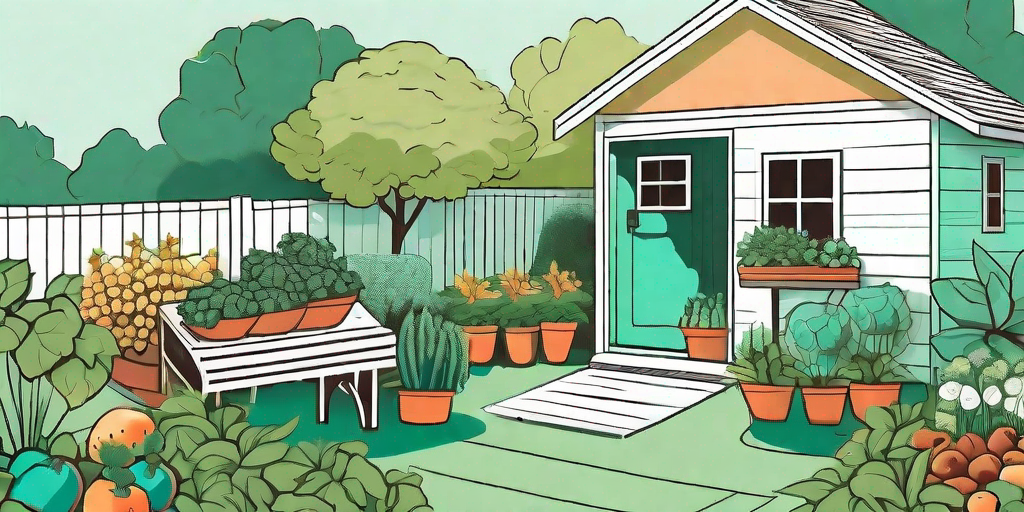
The idea of a self-sufficient garden is not just about growing your own food. It's about creating a space that brings joy, peace, and happiness. It's about connecting with nature and learning to appreciate the simple things in life. And the best part? You don't need a green thumb or a large backyard to get started. All you need is a little bit of patience, a lot of love, and this guide to help you along the way.
Why a Self-Sufficient Garden?
Before we dive into the how-to, let's first explore the why. Why should you consider creating a self-sufficient garden? Well, for starters, it's a fantastic way to reduce your carbon footprint. By growing your own food, you're cutting down on the transportation and packaging that comes with store-bought produce. Plus, you're reducing your reliance on supermarkets, which can be a liberating feeling.
Secondly, it's a great way to save money. Sure, there's an initial investment in seeds and equipment, but once your garden is up and running, you'll be amazed at how much you can save on your grocery bills. Plus, there's something incredibly satisfying about eating a meal made from ingredients you've grown yourself.
Getting Started
Ready to get your hands dirty? Great! But before you start digging, there are a few things you need to consider. First, you need to decide what you want to grow. This will largely depend on your climate, the amount of space you have, and your personal preferences. Do some research and choose plants that are suitable for your conditions.
Next, you need to prepare your soil. This might involve adding compost or other organic matter to improve its fertility. Remember, healthy soil equals healthy plants. Finally, you need to plan your garden. This involves deciding where each plant will go, taking into account their needs for sunlight and space.
Choosing the Right Plants
When it comes to choosing plants for your self-sufficient garden, diversity is key. A mix of fruits, vegetables, herbs, and flowers will not only provide you with a variety of foods, but also create a beautiful and vibrant space that will make you smile every time you step outside.
Consider including plants that are easy to grow and produce a high yield. Tomatoes, zucchini, beans, and lettuce are all great choices for beginners. Herbs like basil, parsley, and mint are also a good addition, as they can be used in a variety of dishes.
Preparing the Soil
Good soil is the foundation of a successful garden. It provides your plants with the nutrients they need to grow and thrive. To prepare your soil, start by removing any weeds or grass. Then, add a layer of compost or well-rotted manure. This will improve the soil's fertility and drainage.
If your soil is heavy clay or sandy, you might need to add other amendments to improve its texture. Clay soil can be improved with coarse sand, compost, and peat moss, while sandy soil can be improved with compost and well-rotted manure.
Planting and Caring for Your Garden
Once your soil is prepared and your plants are chosen, it's time to get planting. This is where the real fun begins! Start by digging a hole that's deep and wide enough for the plant's roots. Place the plant in the hole, making sure the top of the root ball is level with the soil surface. Then, fill in the hole, firm the soil around the plant, and water well.
After planting, your main tasks will be watering, weeding, and feeding your plants. Watering should be done in the early morning or late evening to avoid evaporation. Weeding is important to prevent competition for nutrients and water. Feeding your plants with a balanced organic fertilizer will help them grow strong and healthy.
Harvesting Your Produce
The moment you've been waiting for - harvest time! The timing of your harvest will depend on the type of plant and the weather conditions. As a general rule, fruits and vegetables should be picked when they're fully colored and easily come off the stem. Herbs can be harvested throughout the growing season by picking the leaves as needed.
Remember, the more you harvest, the more your plants will produce. So don't be shy about picking your produce. After all, that's why you started this garden in the first place!
FAQs
How much space do I need for a self-sufficient garden?
The amount of space you need will depend on what you want to grow and how much you want to harvest. However, even a small balcony or patio can be turned into a productive garden with the use of containers and vertical gardening techniques.
What if I don't have a green thumb?
Don't worry, gardening is a skill that can be learned. Start with easy-to-grow plants and gradually expand your garden as you gain confidence. Remember, every gardener has killed a plant or two in their time. It's all part of the learning process!
Can I grow a self-sufficient garden in an apartment?
Absolutely! While you might not be able to grow all your food, you can certainly grow a significant amount. Herbs, salad greens, and small fruits like strawberries can all be grown in containers on a balcony or windowsill.
Conclusion
Creating a self-sufficient garden is a rewarding and fulfilling project that can bring a lot of happiness into your life. Not only will you be able to enjoy fresh, homegrown produce, but you'll also have the satisfaction of knowing you're doing your part to protect the environment.
So why not give it a try? With a bit of planning, a little bit of work, and a lot of love, you can create a garden that not only feeds your body, but also feeds your soul. And that, dear reader, is truly something to smile about.











